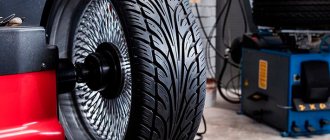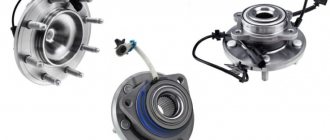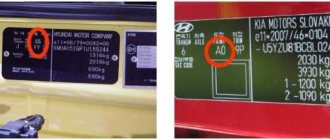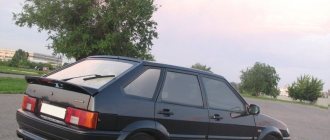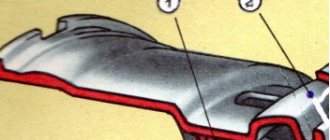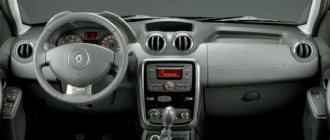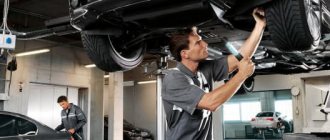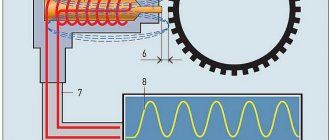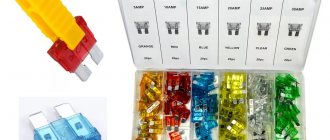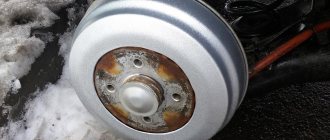Disc labeling
So, let's say you have a disk that displays the following information: 7.5 Jx16 H2 5/112 ET 35 d 58.5
. Let's look at each of the available notations.
7.5Jx16
, the first three, informs us that W - the rim width of this disk - is 7.5 inches (we must remember that almost all disk parameters are indicated in inches: 1 inch = 2.54 cm), D - diameter - is 16 inches, and also that this disk is not stamped/one-piece (“x” is the icon for cast and forged wheels).
Letter J
It’s also in this set for a reason. This letter indicates that the edges of the rim are intended for single-wheel drive cars, so if, for example, your car is all-wheel drive, the discs in question do not fit it and you need to look for identical ones, but with a different marking - JJ.
H2
carries information rather for specialists and informs them that the rim has 2 humps (ring protrusions) necessary to keep tubeless tires from slipping. Naturally, if there is only 1 such protrusion, it will be marked H1 on the marking. It is also possible that there will be a complete absence of such protrusions or their presence, but in a special design, when the symbols will be slightly different (AN, FH, CH). One way or another, for an ordinary motorist this parameter is practically unimportant, which cannot be said about the following numbers.
5/112
- this is a chatterbox.
5 is the number of landing bolts and holes for them, and 112 is the diameter of the circle on which these holes are located, and it is measured not in inches, but in millimeters familiar to a Russian person. There are three ways to find out the disc bolt pattern
, but more on that a little later, but for now let’s look at the remaining parameters.
Marking ET 35
indicates disc ejection. In this example, it is 35 mm; in principle, the offset is the distance between the axis of symmetry of the product and the plane of application of the disk to the hub. When the pressing plane is equal to the center of the disk, then the offset is called zero, when it protrudes beyond the limits, it is negative, and when, on the contrary, the center of the disk is closer to the hub than the plane of application of the disk, such an offset is called positive.
d 58.5
is the diameter of the central hole. When it does not coincide with the diameter of the seat cylinder on the car hub, then it is not at all necessary to look for new disks; you can simply buy an additional set of spacer rings, and then use them to adjust the said elements.
How do motorists solve the problem?
Of course, this does not stop many. The appearance of the car is much more important, especially if it is a BBS.
Agree, such discs look much nicer than . But how to eliminate the vibration problem? There is a solution. This is an eccentric bolt. It has an offset body, thanks to which the element clearly takes its position in the wheel hole. As reviews note, the eccentric bolt is really capable of eliminating vibration when installing discs with abnormal drilling.
Disc drilling and disc bolting: what you need to know
So, if the diameter of the disk and its offset are parameters that directly indicate the possibility of installing the disk on the car, then the CO and the bolt pattern determine the possibility of attaching such a disk to the hub. In other words, a wheel rim may be suitable in offset, diameter, width, etc., but it may not be possible to attach such a rim to the hub correctly.
As a rule, obvious problems with mounting on the hub arise for one reason - the DIA of a particular disk is less than necessary. If the disk center is larger, then the problem is solved with adapter rings. If the disk fails due to the ET offset not being quite suitable, this parameter is also corrected with spacers for the disk.
Unfortunately, having solved the problem with DIA and ET, that is, having made sure whether the disks are suitable, not all car enthusiasts pay due attention to another important parameter - the drilling or bolt pattern of the disk.
- Let's figure out what disc drilling is. So, drilling is carried out at the stage of manufacturing the wheel rim and involves drilling holes of a certain diameter. It is not difficult to guess that these holes are needed for the subsequent installation of fasteners (bolts or studs) when attaching the disk to the hub.
Please note that there are a large number of wheel rim drilling options for different cars. Otherwise, the bolt pattern is different on different cars. For example, you can find the designation PCD 4x100, 5x112, 5x100, 5x114.3, etc.
The German auto industry is characterized by one type of bolt pattern, while Japanese, Korean or American manufacturers use a different drill pattern. Moreover, even Japanese and European manufacturers use different drilling patterns. This means that the bolt pattern of an Audi or the bolt pattern of a Nissan may not be the same as, for example, the bolt pattern of a VAZ or the bolt pattern of a Ford, Honda, BMW, etc.
- However, not all car owners know exactly what type of bolt pattern should be on the car. There are also those who simply ignore this parameter, installing disks with a different drill size, for example, 5x100 instead of 5x114.3. Let us note right away that this is a big mistake for a number of reasons, the main one of which is safety!
It should be understood that drilling the rim holes is a parameter that the wheel manufacturer must calculate with high accuracy. In turn, the car manufacturer also takes into account the features of fixing the wheel to the hub. In this case, even a slight discrepancy between the center of the disk and the hub causes runout.
It is noteworthy that the drill diameter is difficult to determine by eye, and the PCD may differ quite slightly (for example, 5x120 and 5x120.6). Taking into account such features, when choosing rims, you need to know exactly what rim bolt pattern should be on a particular car.
Are there any pitfalls?
Please note that if the drilling of the Niva (or any other VAZ) rims does not match the parameters of the wheels being installed, when using a spacer you have:
- The departure parameter will change. The wheel will be located a little closer to the arch, the track width will increase. If you have a lowered suspension, the rubber may rub against the edge of the arches. This will cause discomfort when driving (the noise will be incredible), and possibly tear the sidewall of the tire.
- The load on the wheel bearing will increase. Its resource will be reduced by about 10 percent. The spacer will act as a lever in this case.
Otherwise, the characteristics of the car will not change. If you don’t want to spend money on spacers, and the number of bolts is the same, you can use spacer rings.
They are made of polycarbonate and can withstand temperatures up to 280 degrees Celsius. This is the cheapest solution when changing disc drilling. The cost of one ring is 45 rubles.
Useful tips
First of all, if you use original “standard” wheels, all parameters (DIA, PCD, ET) will be exactly as provided by the car manufacturer. For this reason, the cost of original cast or forged wheels is quite high, and the choice of models is quite limited. Unfortunately, the most suitable price option when choosing standard discs is a regular stamped steel disc.
- If you choose from non-original disks, then you should pay attention to all parameters without exception. The fact is that it is difficult to find a disk that will fully comply with the factory parameters. The reason is that manufacturers are trying to make the wheels as universal as possible, that is, to realize the possibility of installing them on as many different cars as possible.
As a result, the center hole of the DIA is often larger than necessary. A set of adapter rings should be used for adjustment. As for PCD, wheel alignment is realized by drilling. For discs with an unsuitable offset, but suitable drilling, spacers are used between the mating plane of the disc and the hub. This way it is possible to correct the disc offset.
In this case, complete centering is carried out along conical or spherical surfaces while fastening the disk with bolts or nuts. However, taking into account the fact that manufacturers of non-original disks perform drilling with certain diameter tolerances in a larger direction, it can be difficult to select a disk according to PCD.
In this case, differences of even 2 mm (for example, instead of 4x100, install a 4x98 disk) can lead to dire consequences. The fact is that in this case, of all 4 nuts or bolts, only one will be properly tightened, while the other three will not be in the desired position. The result is that the fasteners will not be tightened or will be tightened with distortions. One way or another, the wheel will not completely “sit” on the hub.
Naturally, when driving, even taking into account normal wheel balancing, vibrations will occur, fasteners will experience heavy loads, wheel nuts may become unscrewed, etc. It turns out that even a slight deviation in the bolt pattern is unacceptable, since to fix the wheel the bolts must be tightened very tightly, and the nuts will still not be tightened.
- The solution in this situation, when the disk drilling parameter does not coincide with the standard one, is to use special fasteners. On machines with a bolt-on disc, use a special eccentric bolt with an offset cone.
This fastener is rare compared to bolts, but if necessary, you can look for just such an option. By the way, it is important to use centering rings together with this type of fastener, since these solutions are supposed to be used in parallel.
We also note that on sale you can find disks with double drilling (for example, drilling 5x100/114.3). On such a disk 10 holes will be made at once, with the first 5 for drilling 100, and the remaining ones for 114.3. The solution allows the use of such wheels on cars whose wheel bolt pattern should be 5x100 or 5x114.3.
How to measure yourself
It’s possible to find out the bolt pattern yourself; this is possible with a ruler (preferably a caliper). They measure the distance between the windows, and the ruler has an error because it does not take into account the bend. You can take measurements in several ways, which are combined for greater accuracy.
Adjacent holes
This parameter is determined taking into account the indicator of the circle where the central part of the slot made for the mounting bolts is located. The diameter can be easily calculated using a ruler, although a compatibility table has been developed for popular cars. If a ruler is used, then the distance between adjacent bolts is measured in a straight line.
The resulting figure is multiplied by a coefficient determined by the number of holes in the disk. It should be said right away that the transverse circumference of VAZ cars is standardized at 98 mm, and in Niva it is 139.7 mm. The coefficients are as follows:
- 3 bolts - 1.155;
- 4 fasteners - the value for multiplication is 1.414;
- 5 — 1,701;
- 6 bolts - 2;
- 10 pins - 3.326.
Far windows
Instead of nearby holes, you can determine the bolt pattern even with a ruler with minimal error, using distant windows. The easiest way to measure wheels is if there is an even number of bolts - 4,6,8. The length of a straight line drawn between opposite holes will indicate the required value.
If there are 5 bolts on the disk, the distance between holes that are not adjacent is measured. The resulting figure is multiplied by a coefficient of 1.051, which gives the most accurate PCD result.
Hub window diameter
The hub center window size is specified in the bolt pattern charts and the complete bolt pattern formula mentioned below. Even if there is no ready-made information at hand, the results can be easily obtained with a ruler or a more accurate caliper. For example, the window diameter in the VAZ model 2110 is made at 58.6 mm.
Interesting!
It is not always possible to measure this indicator due to the irregular shape; Daewoo Nexia has such in its pre-restyling body.
In addition to the listed characteristics, disc offset is also important. It refers to the location of the vertical axes of symmetry of the wheel in relation to the point of alignment with the hub. The offset can be negative, as well as zero or positive, but even if the selection for it was unsuccessful, the disk can be installed. This is undesirable, because the car’s suspension will begin to function incorrectly and will greatly impair driving safety.
